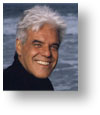  |
|
|

Surfers in Danger of Becoming the Beachless Boys
Beaches are disappearing mostly because of dams and seawalls. It's hardly a surprise. For thirty years scholars like Doug Inman at Scripps Institute and Professor Gary Griggs at UC Santa Cruz have been warning us about the problem of sand starvation on California's beaches. Ask anyone in Oceanside or Del Mar if they were right. What most people don't know
is that 70 to 90 percent of the sand on California beaches comes from
rivers. Our beaches
"Our
beaches are starving because millions of tons of sand-laden sediments
are now trapped behind 1400 dams." For thirty years, environmental groups like Friends of the River (FOR) and the Sierra Club and fishing organizations like Cal Trout have been calling for the removal of dams and the restoration of riverbanks and fisheries. Now, surfers are weighing in on the issue. "Looking at sand like a slow moving liquid makes it arguable that sand fits within the public trust doctrine, the same way water was included by the Supreme Court in the landmark Mono Lake case," explains surfer and environmental attorney Chip Post. "Damming and diverting rivers prevent the natural flow of sand to the beaches. Sand-starved beaches are a diminished environmental and recreational resource and a weakened shore protector. We believe the state has a duty under the public trust doctrine to find a way to restore the sand to the beaches," says Post. Friends of the River recently published a report on dam removal entitled Rivers Reborn. The report outlines the growing body of scientific evidence that restoration is feasible and economically beneficial. Many of the dams are completely silted up, some are dangerous, and it is less expensive to remove them than try to prop them up. FOR's report includes a Top Ten List of dams that could be removed. Most of these dams are in Northern California, but two in Southern California are of special interest to surfers. Just upstream from Malibu, one of California's most famous surfing beaches, is the l00 foot high Rindge Dam. It was built in l926 to irrigate lima bean farms. It has been completely filled with sediment for 25 years, and it traps between 800,000 and l,600,000 cubic yards of sand and sediment. It could be notched and drained over several years. In Ventura County, the Matijilla Dam is 15 miles upstream from the beach and is backing up six million cubic yards of sand, enough to fill dump trucks stretching from Malibu to Virginia Beach and widen every beach in Ventura County by eleven feet. Surfers are actively involved in the effort to remove this structure. Senators Dianne Feinstein and Barbara Boxer and Secretary of the Interior Bruce Babbit are supporting the effort. They could start tearing it down as early as this fall. In addition to dams, seawalls are a growing threat to the health of our beaches, especially as we persist in driving gas-guzzlers and accelerating the sea level rise associated with global warming. Twenty percent of the sand
on our beaches comes from the natural erosion of bluffs. Building seawalls
stops this erosion
"We
won't solve the problems created by yesterday's
unwise coastal development decisions by foolishly
wasting millions today." We need a long range retreat strategy, so that bluffs can erode the way they are supposed to and add their contribution to the beaches. We won't solve the problems created by yesterday's unwise coastal development decisions by foolishly wasting millions today on seawalls. And the taxpayers shouldn't get stuck with paying for seawalls to protect homes that shouldn't have been built in the first place. State Senator Byron Sher (D - Palo Alto) has introduced Senate Bill l540. His bill, "The California Dam Decommission River Restoration and Public Safety Act of 2000," requires the California Secretary of Resources to prepare an inventory and evaluation of dams suitable for removal or modification to improve fish passage. The Secretary would also be required to develop cost estimates for the work needed to remove or modify dams as recommended in the report. SB 1540 also establishes a Dam Decommissioning Fund in the State Budget to fund dam removal and modification. Every beach lover should immediately write or call his or her state legislators supporting SB 1540. Eighty percent of California's 33 million people live within 30 miles of the coast. The state's beach parks represent only 3 percent of its park land but attract 72 percent of park visitors. The State of California reaps huge economic benefits from beach lovers. Beaches produce $15 billion a year for the state's economy. But just ask any surfer -- mere bucks cannot measure the value of the great waves. Robert Caughlan was a co-founder of Friends of the River, and served six terms as president of the Surfrider Foundation. He led the surfers to victory in one of the nation's largest Clean Water Act enforcement lawsuits. Caughlan
was a member of the White House staff under President Carter, was a
special assistant at the Environmental Protection Agency, and was general
partner in Voice of the Planet, a ten-part television series on global
environmental issues produced by Turner Broadcasting and starring William
Shatner and Faye Dunaway. |
|
Home | History & Archive | Video Productions & Services © Copyright 1998-2023 EcoIQ
|












 By
By
